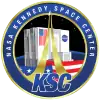Space Station Processing Facility
The Space Station Processing Facility (SSPF) is a three-story, 42,500 m2 (457,000 sq ft) industrial building located in the Kennedy Space Center industrial area, just east of the Operations and Checkout Building.[1] It was constructed in 1992 for the manufacturing and processing of the International Space Station modules, flight hardware, equipment, structural components and solar arrays. The SSPF includes two processing bays, an airlock, operational control rooms, laboratories, logistics areas, office space, a ballroom and conference halls, and a cafeteria. The processing areas, airlock, and laboratories were designed to support non-hazardous Station and Space Shuttle payloads in 100,000 class clean work areas.
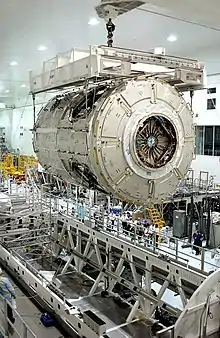 Interior of the SSPF, showing Node 2 being hoisted by overhead cranes | |
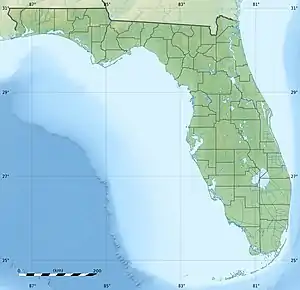 Location in Florida  Space Station Processing Facility (the United States) | |

| |
| Built | 1992 |
|---|---|
| Location | Kennedy Space Center |
| Coordinates | 28°31′26″N 80°38′39″W |
| Industry | Aerospace and Space Technology |
| Products | Space Station Modules and Equipment |
| Employees | 700+ |
| Architect | KSC Management |
| Buildings | 1 |
| Area | 42,500 m2 (457,000 sq ft) |
| Address | NASA Parkway East |
| Owner(s) | NASA |
History and construction

During the re-designing phase of Space Station Freedom in early 1991, Congress approved new plans for NASA to lead the project and begin manufacturing its components for the future International Space Station. Kennedy Space Center was selected as the ideal launch processing complex for the ISS, as well as hosting all the internationally manufactured modules and station elements.
However the Operations and Checkout Building (which was originally to be the prime factory for station launch processing) was insufficient in size to accommodate all the components. On March 26, 1991, engineers at Kennedy Space Center; along with contractor Metric Constructions Inc. of Tampa Florida, broke ground on a new $56 million Space Station Processing Facility, situated adjacent to the O&C. The design called for a 457,000-square-foot multifunction building housing an enormous processing bay, laboratories, control rooms, staging areas, communications and control facilities, and office space for some 1,400 NASA and contractor employees.[2]
KSC Deputy Director Gene Thomas described the construction: "The skyline around here is really going to change. This will be the biggest facility that we have built since the Apollo days". The SSPF used reinforced concrete and some 4,300 tons of steel. The building was structually completed and topped out by mid 1992. After three years of construction, interior fitting and equipment set-up, the SSPF formally opened on June 23, 1994.
Station Integration Testing
.jpg.webp)
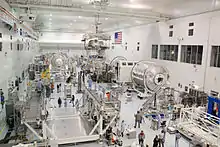
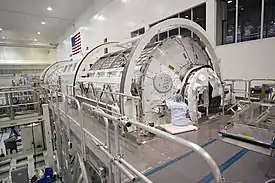
Regarding the launch of modules of the International Space Station (ISS), there had been philosophical differences for years between designers and payload processors whether to ship-and-shoot or perform integration testing prior to launch. The former involved building a station module and launching it without ever physically testing it with other modules. The integration testing was not originally in the ISS plan, but in 1995 Johnson Space Center designers began to consider it and embedding KSC personnel at module factories. Multi-Element Integration Testing (MEIT) of ISS modules at KSC was officially in the books in 1997.[3][4][5]
"Three MEIT and one Integration Systems Test (IST) tests were conducted for the ISS," taking about three years from planning to completion and closure:[6]
- MEIT1: US Lab, Z1 truss, P6 truss, and a Node 1 emulator
- Planning began in 1997, Testing began January 1999
- MEIT2: S0 truss/Mobile Transporter/Mobile Base System, S1 truss, P1 truss, P3 truss, P4 truss, and a US Lab emulator.
- MEIT3: Japanese Experiment Module, Node 2, and the US Lab emulator
- Completed in 2007
- Node2 IST: Node 2 and US Lab and Node 1 emulators, as part of the ISS Flight Emulator
After the launch of the Destiny, an emulator was built for MEIT testing, since the lab controlled many other modules. Among the items checked were mechanical connections, the ability to flow power and fluids between modules, and the flight software.
Numerous issues were found from these on the ground tests, many of which could not have been fixed in orbit. Many of the builders accompanied their modules from around the world and worked at KSC for months to years during testing. Many of the modules were renamed after successfully launching.
Operations and manufacturing processes
At the SSPF, space station modules, trusses and solar arrays are prepped and made ready for launch. The low and high bays are fully air conditioned and ambient temperature is maintained at 12 °C (54 °F) at all times. Workers and engineers wear full non-contaminant clothing while working. Modules receive cleaning and polishing, and some areas are temporarily disassembled for the installation of cables, electrical systems and plumbing. In another area, shipments of spare materials are available for installation. International Standard Payload Rack frames are assembled and welded together, allowing the installation of instruments, machines and science experiment boxes to be fitted. Once racks are fully assembled, they are hoisted by a special manually operated robotic crane and carefully maneuvered into place inside the space station modules. Each rack weighs from 700 to 1,100 kg, and connect inside the module on special mounts with screws and latches.[7]
Cargo bags for MPLM modules are filled with their cargo such as food packages, science experiments and other miscellaneous items on-site in the SSPF, and loaded into the module by the same robotic crane and strapped in securely.
Building Specifications
.jpg.webp)
The SSPF's High Bays provide maximum flexibility for manufacturing, assembly, testing and processing payloads and elements destined for space. The bays are enormous cleanrooms equipped with overhead cranes, commodities-servicing equipment and a secure backup-power supply. The facility also has 15 offline labs.[8]
Intermediate Bay (I-bay)
- Dimensions: 338 ft (103 m) in length, by 50 ft (15 m) in width
- Ceiling height 30 ft (9.1 m)
- 100,000-class clean work area
High Bay
- Dimensions 472 ft (144 m) in length, by 121 ft (37 m) in Width
- Ceiling height 69 ft (21 m)
- Can be separated into eight different processing areas
Cranes
- I-bay: Two 5,000 kg (11,000 lb) capacity
- High Bay: Two 30,000 kg (66,000 lb) capacity
Commodities and Servicing Equipment
- Ammonia servicing machines
- Compressed air supply (125 psi)
- Potable water pipes
Electrical Services
- 480 V 3-phase power at 60 Hz
- Uninterruptible power supply (450 kVA)
Laboratory facilities
- 9 independently operated control rooms
- 15 labs, 2 chemical labs, and 2 darkrooms
- 1 Certified offline lab for planetary protection processing (Class-100 clean work area)
- 3 ISS Environmental Simulator (ISSES) Chambers, can be used to expose ISS life science ground controls to ISS environmental conditions (i.e., temperature, humidity).
- Experiment Monitoring Area (EMA), used to monitor ISS life science experiments
Office floor area: 140,000 sq ft (13,000 m2) of office/work space
Station components currently in the SSPF

As of 10 November 2019:
- Multi-Purpose Logistics Modules Raffaello and Donatello.
- Two Lightweight Multi-Purpose Equipment Support Structure Carriers (LMCs).
- Node 1 Structural Test Article (STA) - to become Node 4.
- Lunar Gateway habitat module, built by Lockheed Martin - used as a training rig.[9]
- Interim Cryogenic Propulsion Stage, the upper stage for the Space Launch System.
- Dream Chaser 'mini space shuttle' - designed and manufactured by Sierra Nevada Corporation.
When the lights in the building are on, most of these components can be seen on the live webcam from the facility.[10]
Current and Future activities
After the completion of the International Space Station in 2011, the SSPF factory was dormant for several months until early 2012, where the building was slightly refurbished for the moving in of space companies (such as Orbital ATK, SpaceX and eventually Sierra Nevada Corporation) to manufacture, process and load-up Cygnus and Dragon spacecraft[11] and on-board payloads, as part of the Commercial Resupply Services program. NASA's upcoming Artemis mission hardware such as Moon and Mars space station modules, as well as the Dreamchaser mini space shuttle,[12] have begun manufacturing and processing operations in the high bay as of 2020.[13]
The building itself is open to the public and tours are offered free of charge by the employees.[14] Exclusive tours of many areas of the SSPF are part of the Kennedy visitor complex's enhanced bus tour package.[15][16]
In 2016, the laboratories of the SSPF were utilized by many small science companies and student unions with scientific equipment to study the feasibility of growing vegetables in space, such as the Veggie plant growth system, and the Advanced Plant Habitat; to launch as scientific payloads to the International Space Station.[17]
Events
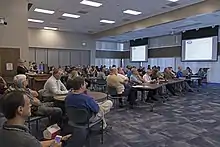
When the high bay area is less busy at times, a variety of events and conferences are held in various places within the SSPF building. Occasional STEM exhibitions take place where visitors (from children and teenagers to university students)[18][19] can visit the SSPF and its ballroom to learn about the building's history,[20] manufacturing acitivies, biological and chemical sciences, and the future vision of space operations at Kennedy Space Center, including the Lunar Gateway mockup module.[21][22][23] The ballroom also doubles as a lecture hall for presentations.[24] On rare occasions the high bay was once used for the National Space Council's second revived meeting on February 21, 2018.
Tenants including Northrop Grumman, Lockheed Martin and Airbus have also moved facilities into the SSPF.[25][26]
Gallery
 The exterior of the SSPF viewed from NASA Parkway
The exterior of the SSPF viewed from NASA Parkway Aerial view of the SSPF in 1995
Aerial view of the SSPF in 1995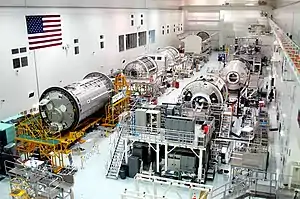 International Space Station modules being manufactured in the SSPF main workshop area
International Space Station modules being manufactured in the SSPF main workshop area The main entrance to the facility
The main entrance to the facility An MPLM being hoisted by overhead cranes
An MPLM being hoisted by overhead cranes
 The main Kibo module in its manufacturing workstand, c. 2003
The main Kibo module in its manufacturing workstand, c. 2003 Kibo JLP module transfer to the payload transfer container
Kibo JLP module transfer to the payload transfer container Tranquility in the SSPF.
Tranquility in the SSPF.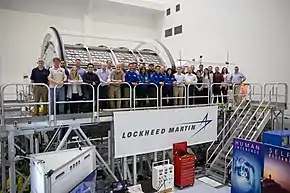 NASA and Lockheed Martin employees group photo with the Lunar Gateway module training mock-up inside the SSPF
NASA and Lockheed Martin employees group photo with the Lunar Gateway module training mock-up inside the SSPF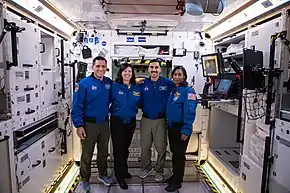 Inside the Lunar Gateway mock-up module, with four astronauts.
Inside the Lunar Gateway mock-up module, with four astronauts..jpg.webp) Loading yard
Loading yard.jpg.webp) Orbital ATK Cygnus CRS-0A-7
Orbital ATK Cygnus CRS-0A-7.jpg.webp) ISS Cargo bags
ISS Cargo bags SSPF lobby
SSPF lobby Actor Tommy Lee Jones while visiting the SSPF high bay, near the Kibo module
Actor Tommy Lee Jones while visiting the SSPF high bay, near the Kibo module A view of an empty workstand from the high bay observation windows
A view of an empty workstand from the high bay observation windows The main visitor entrance lobby to the SSPF in September 2019. Note the signage displays 'International' in addition to the building's name, but is not official.
The main visitor entrance lobby to the SSPF in September 2019. Note the signage displays 'International' in addition to the building's name, but is not official. The Bishop Airlock Module being made by Nanoracks in the high bay, October 7, 2020.
The Bishop Airlock Module being made by Nanoracks in the high bay, October 7, 2020. Scientists and students working on SpaceX CRS-21 returned science experiments in the SSPF lab workshop, January 2021
Scientists and students working on SpaceX CRS-21 returned science experiments in the SSPF lab workshop, January 2021
References
| Wikimedia Commons has media related to Space Station Processing Facility. |
- NASA. "Space Station Processing Facility". Archived from the original on February 6, 2007. Retrieved February 8, 2007.
- "Discovery STS-39 – Sky Ballet". forum.nasaspaceflight.com.
- Lipartito, Kenneth; Butler, Orville (2007). 'A History of the Kennedy Space Center. University Press of Florida. ISBN 978-0-8130-3069-2.
- "International Space Station Program/Hardware/Multi-Element Integration Testing (MEIT)". Lessons Learned. NASA. February 1, 1999. Archived from the original on March 5, 2016. Retrieved November 6, 2015.
- "International Space Station (ISS) Program/Ground Processing Schedule/Test and Verification". Lessons Learned. NASA. February 1, 1997. Archived from the original on March 5, 2016. Retrieved November 6, 2015.
- Beyer, Jeff (October 2009). "STRATEGIES FOR GROUND BASED TESTING OF MANNED LUNAR SURFACE SYSTEMS" (PDF). NASA Technical Reports Server (NTRS). NASA. Archived (PDF) from the original on February 27, 2017. Retrieved November 6, 2015.
- mediaarchive.ksc.nasa.gov/detail.cfm?mediaid=51708
- https://kscpartnerships.ksc.nasa.gov/Partnering-Opportunities/Capabilities-and-Testing/Physical-Assets/Space-Station-Processing-Facility
- "NextSTEP Lunar Habitat". March 5, 2019 – via Flickr.
- NASA. "Space Station Processing Facility - KSC Video Feeds". Archived from the original on February 8, 2007. Retrieved February 8, 2007.
- https://images.nasa.gov/details-KSC-20200130-PH-JBS01_0035
- https://images.nasa.gov/details-KSC-20200603-PH-KLS01_0055
- https://images.nasa.gov/details-KSC-20190516-PH_KLS01_0062
- "NASA KSC Space Station Processing Facility (SSPF)". Foursquare.
- https://cscmp.org/store/events/registration.aspx?event=CFL190924
- https://www.kennedyspacecenter.com/explore-attractions/behind-the-gates/kennedy-space-center-explore-tour
- https://images.nasa.gov/details-KSC-20190516-PH_KLS01_0013
- https://images.nasa.gov/details-KSC-20160302-PH-CSH01_0092
- https://images.nasa.gov/details-KSC-2014-3541
- https://images.nasa.gov/details-KSC-20161102-PH_KLS01_0042
- https://images.nasa.gov/details-KSC-20161102-PH_KLS01_0176
- https://images.nasa.gov/details-KSC-20190918-PH_CSH01_0038
- https://images.nasa.gov/details-KSC-20190325-PH_KLS01_0144
- https://images.nasa.gov/details-KSC-20190312-PH_KLS01_0038
- https://images.nasa.gov/details-KSC-20200130-PH-JBS01_0005
- https://images.nasa.gov/details-KSC-20190920-PH-KLS01_0013
.jpg.webp)

